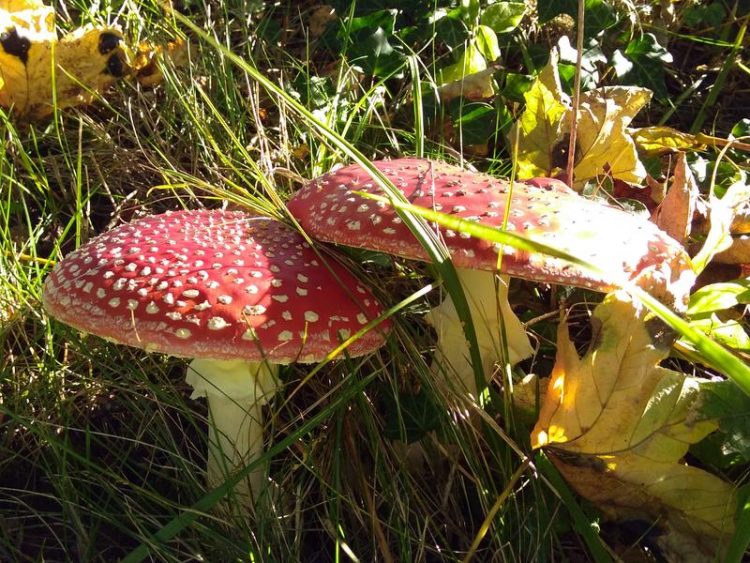The amazing genes of the fly agaric

The toxic effects of the fly agaric are caused by the active substance ibotenic acid and muscimol. Credit: Sebastian Obermaier
The white-spotted fly agaric is probably the most famous of all forest fungi. That is not just due to its characteristic appearance, but also due to its notorious toxicity. Some earlier cultures even made use of Amanita muscaria’s psychoactive effects. These effects are caused by the active substance ibotenic acid and its degradation product muscimol.
The chemical structure of these toxins has been known since the mid-20th century. Yet, how they are produced by the toadstool – their so-called biosynthesis – has remained obscure.
Prof. Dr. Michael Müller and Dr. Sebastian Obermaier of the Institute of Pharmaceutical Sciences at the University of Freiburg have now succeeded in identifying the genes which give the fungus its ability to make these toxins. Demonstrating the starting point of the biosynthesis, the researchers have presented their findings in the scientific journal Angewandte Chemie.
Their examination of the fly agaric genome led the Freiburg pharmacologists to a segment of DNA comprising seven genes. Under certain growing conditions, these genes become active simultaneously, which suggests that they all serve a common purpose.
The related Amanita pantherina, which also produces ibotenic acid, contains an analogous DNA segment. Yet, other related mushrooms which do not contain ibotenic acid lack these seven genes, indicating a connection between the genes and the production of the toxins.
In order to verify whether this DNA segment is responsible for the biosynthesis, Müller and Obermaier transferred one of the genes into the model bacterium Escherichia coli.
The modified bacteria were then able to convert the amino acid glutamate into a precursor of ibotenic acid, 3 hydroxyglutamate. This confirmed the function of the genes discovered in the fly agaric – they are responsible for the biosynthesis of ibotenic acid.
“Interestingly, 3 hydroxyglutamate was predicted to be the precursor of ibotenic acid more than 50 years ago,” says Obermaier, “but it wasn’t found in the fly agaric back then.” Using modern genetic and analytical methods, the Freiburg researchers have confirmed the old hypothesis.
“This shows what technical progress science has made in recent decades,” Müller says. “And it also demonstrates how old ideas can provide impetus to today's research.”
Publication:
Obermaier, S., Müller, M. (2020): Ibotenic Acid Biosynthesis in the Fly Agaric Is Initiated by Glutamate Hydroxylation. In: Angewandte Chemistry International Edition. DOI: 10.1002/anie.202001870
Contact:
Professor Dr. Michael Müller
Institute for Pharmaceuticals Sciences
University of Freiburg
Phone: 0761/203-6320
michael.mueller@pharmazie.uni-freiburg.de
https://www.onlinelibrary.wiley.com/doi/abs/10.1002/anie.202001870?af=R
Media Contact
All latest news from the category: Life Sciences and Chemistry
Articles and reports from the Life Sciences and chemistry area deal with applied and basic research into modern biology, chemistry and human medicine.
Valuable information can be found on a range of life sciences fields including bacteriology, biochemistry, bionics, bioinformatics, biophysics, biotechnology, genetics, geobotany, human biology, marine biology, microbiology, molecular biology, cellular biology, zoology, bioinorganic chemistry, microchemistry and environmental chemistry.
Newest articles

First-of-its-kind study uses remote sensing to monitor plastic debris in rivers and lakes
Remote sensing creates a cost-effective solution to monitoring plastic pollution. A first-of-its-kind study from researchers at the University of Minnesota Twin Cities shows how remote sensing can help monitor and…

Laser-based artificial neuron mimics nerve cell functions at lightning speed
With a processing speed a billion times faster than nature, chip-based laser neuron could help advance AI tasks such as pattern recognition and sequence prediction. Researchers have developed a laser-based…

Optimising the processing of plastic waste
Just one look in the yellow bin reveals a colourful jumble of different types of plastic. However, the purer and more uniform plastic waste is, the easier it is to…



